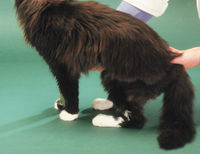|
What is the most likely cause of this posture?
A 7-year-old male neutered DSH is presented because it has an abnormal gait (walking with the hocks touching the ground) and posture. There is no history of trauma and the owner believes that these abnormalities have developed over the last few weeks. On further questioning, the owner reveals that the cat has been losing weight for the last 2 months, during which time it has also been noticeably polydipsic and polyuric.
Test yourself here.
Follow us on Twitter to get notified whenever a new page is released and to receive teaser questions! You can also find them on our Facebook page.
If you have some teaching resources like these that you would like to make available via WikiVet, why not contact the WikiVet team? If you have any comments or suggestions, please feel free to email the WikiVet team or you can post a comment on our Facebook page!
| 



